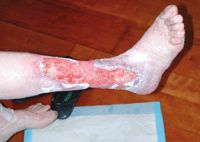- Acne
- Actinic Keratosis
- Aesthetics
- Alopecia
- Atopic Dermatitis
- Buy-and-Bill
- COVID-19
- Case-Based Roundtable
- Chronic Hand Eczema
- Chronic Spontaneous Urticaria
- Drug Watch
- Eczema
- General Dermatology
- Hidradenitis Suppurativa
- Melasma
- NP and PA
- Pediatric Dermatology
- Pigmentary Disorders
- Practice Management
- Precision Medicine and Biologics
- Prurigo Nodularis
- Psoriasis
- Psoriatic Arthritis
- Rare Disease
- Rosacea
- Skin Cancer
- Vitiligo
- Wound Care
Article
Wound age, size define, difficult-to-heal ulcers
New York - Simple clinical characteristics determined as part of the usual examination allow for reliable prognostication of the response of venous leg ulcers to standard therapy, and that information is useful formanaging patients in everyday practice as well as when conducting clinical trials, said David J. Margolis, M.D., Ph.D, at the American Academy of Dermatology (AAD) Academy '04 here recently.

Based on research he conducted in his own cohort of 260 patients, Dr.Margolis, associate professor of dermatology and epidemiology, University of Pennsylvania School of Med-icine, Philadelphia, determined that wounds could be categorized as being likely or not likely to heal after 24 weeks of limb compression therapy, knowing only wound size and duration. The performance of a predictive model based on those factors alone remained robust when it was tested using a much larger dataset of more than 20,000 wounds.
"The availability of a clinically useful prognostic model is especially helpful for managing patients with venous leg ulcers since those wounds are characterized by a prolonged healing period with a substantial delay before improvement is apparent, and their therapy can be difficult to administer and to tolerate," says Dr. Margolis. "As these patients return for frequent follow-up early during therapy, it is not unusual for them to question whether they are responding and if it is worthwhile to continue the same course of care.
Added value The prognostic model will take on added value as new therapies for venous leg ulcers emerge, including not only cell-based therapies and growth factors but also surgical interventions.
"The ability to predict outcome will be helpful in determining appropriate resource allocation. Knowing which wounds are likely to heal with conventional therapy, dermatologists can discriminate between patients they should continue to manage and those who would be better served by referral for alternative care," Dr. Margolis says.
The prognostic model was initially developed based on data from a retrospective cohort study of patients treated at the Cutaneous Ulcer Center between 1993 and 1995. A number of patient- and wound-related characteristics were tested as predictors of healing within six months, and in a covariate-adjusted model, wound area and duration were independently associated with outcome (odds ratio 1.19 and 1.09, respectively). Those two factors were used to develop a prognostic model in which wounds were scored by area (·5 cm2 or >5 cm2 ) and age (· 6 months or > 6 months).
Further studies were conducted using the large database from Curative Health Services (CHS). While a number of different prognostic models of varying complexity were tested, the simple model based only on wound size and duration was found to accurately predict the likelihood of healing by 24 weeks (ROC = 0.70, Brier score = 0.0001). The addition of other prognostic factors previously shown to more strongly predict outcome, such as gender and age, did not improve the accuracy of the model, Dr. Margolis reports.
Validation The two-factor prognostic model was validated using the CHS database. Dr. Margolis and his colleagues categorized wounds into four groups according to size (·10cm2 or >10 cm2 ) and duration (<12 months, Ž12 months). For a wound <10cm2 and <12 months old, both the modeled and expected likelihood of not healing by 24 weeks was 29 percent. The greatest difference between the observed and predicted outcomes was for wounds >10cm2 with a duration Ž12 months. Those wounds were predicted to have a 74 percent likelihood of not healing, while the observed likelihood was 78 percent.
Early response predictions In addition to those baseline features, various studies show that measurement of wound improvement after the first four weeks of intervention is also helpful in determining the prognosis of venous leg ulcers.
Newsletter
Like what you’re reading? Subscribe to Dermatology Times for weekly updates on therapies, innovations, and real-world practice tips.











